Page 2919 of 3383
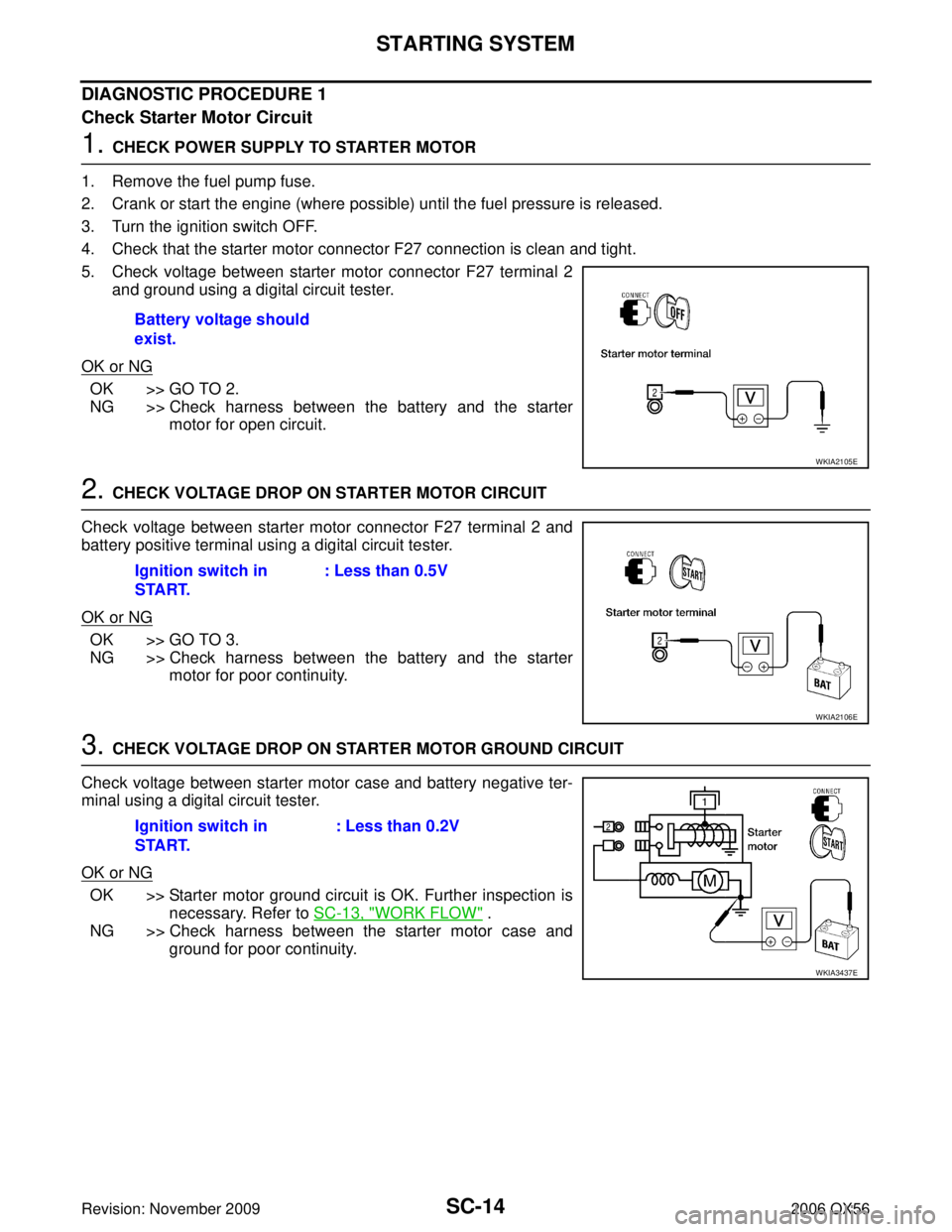
SC-14
STARTING SYSTEM
Revision: November 20092006 QX56
DIAGNOSTIC PROCEDURE 1
Check Starter Motor Circuit
1. CHECK POWER SUPPLY TO STARTER MOTOR
1. Remove the fuel pump fuse.
2. Crank or start the engine (where possible) until the fuel pressure is released.
3. Turn the ignition switch OFF.
4. Check that the starter motor connector F27 connection is clean and tight.
5. Check voltage between starter motor connector F27 terminal 2 and ground using a digital circuit tester.
OK or NG
OK >> GO TO 2.
NG >> Check harness between the battery and the starter motor for open circuit.
2. CHECK VOLTAGE DROP ON STARTER MOTOR CIRCUIT
Check voltage between starter motor connector F27 terminal 2 and
battery positive terminal using a digital circuit tester.
OK or NG
OK >> GO TO 3.
NG >> Check harness between the battery and the starter motor for poor continuity.
3. CHECK VOLTAGE DROP ON STARTER MOTOR GROUND CIRCUIT
Check voltage between starter motor case and battery negative ter-
minal using a digital circuit tester.
OK or NG
OK >> Starter motor ground circuit is OK. Further inspection is necessary. Refer to SC-13, "
WORK FLOW" .
NG >> Check harness between the starter motor case and ground for poor continuity.
Battery voltage should
exist.
WKIA2105E
Ignition switch in
START.
: Less than 0.5V
WKIA2106E
Ignition switch in
START. : Less than 0.2V
WKIA3437E
Page 2920 of 3383
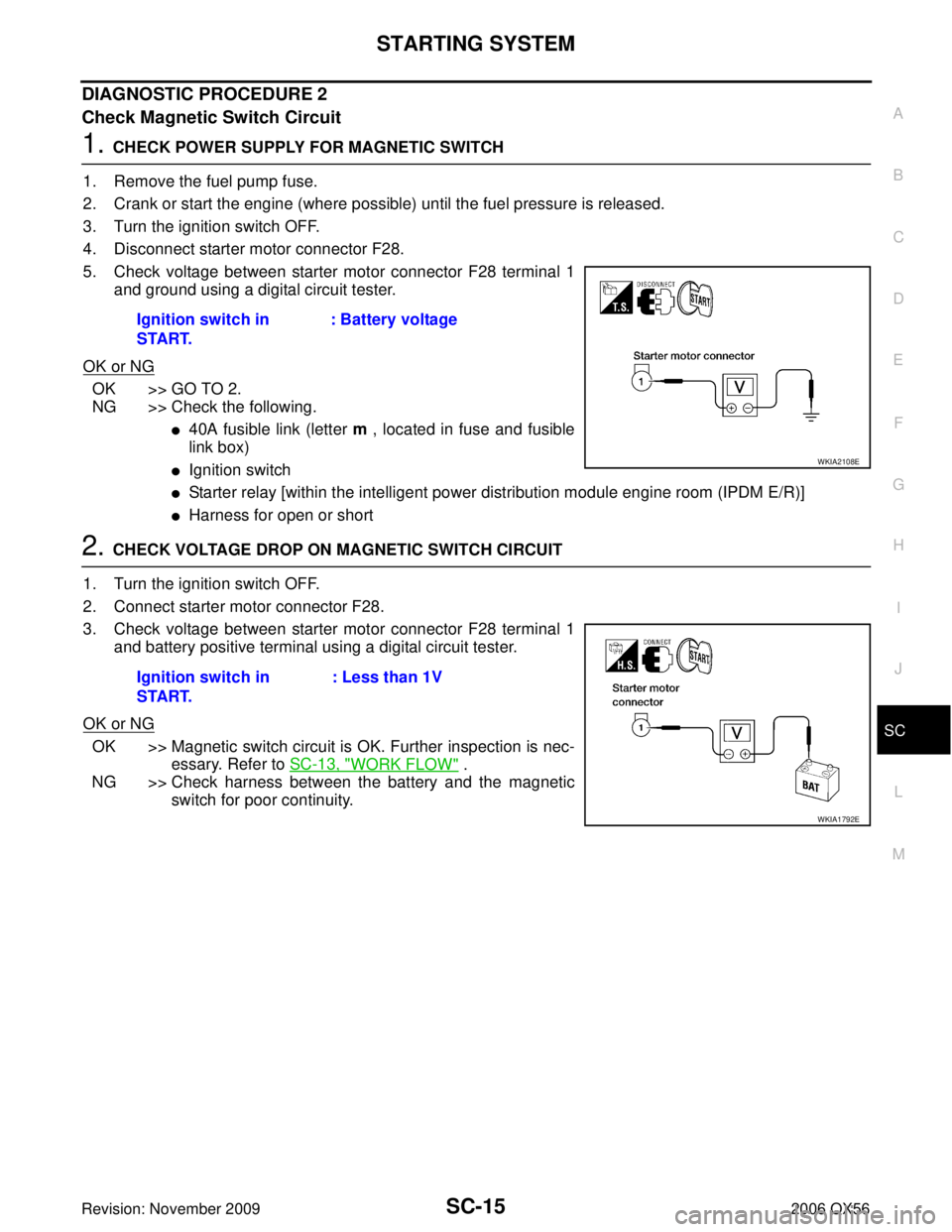
STARTING SYSTEMSC-15
C
DE
F
G H
I
J
L
M A
B
SC
Revision: November 2009 2006 QX56
DIAGNOSTIC PROCEDURE 2
Check Magnetic Switch Circuit
1. CHECK POWER SUPPLY FOR MAGNETIC SWITCH
1. Remove the fuel pump fuse.
2. Crank or start the engine (where possible) until the fuel pressure is released.
3. Turn the ignition switch OFF.
4. Disconnect starter motor connector F28.
5. Check voltage between starter motor connector F28 terminal 1 and ground using a digital circuit tester.
OK or NG
OK >> GO TO 2.
NG >> Check the following.
�40A fusible link (letter m , located in fuse and fusible
link box)
�Ignition switch
�Starter relay [within the intelligent power distribution module engine room (IPDM E/R)]
�Harness for open or short
2. CHECK VOLTAGE DROP ON MAGNETIC SWITCH CIRCUIT
1. Turn the ignition switch OFF.
2. Connect starter motor connector F28.
3. Check voltage between starter motor connector F28 terminal 1 and battery positive terminal using a digital circuit tester.
OK or NG
OK >> Magnetic switch circuit is OK. Further inspection is nec- essary. Refer to SC-13, "
WORK FLOW" .
NG >> Check harness between the battery and the magnetic
switch for poor continuity.
Ignition switch in
START.
: Battery voltage
WKIA2108E
Ignition switch in
START. : Less than 1V
WKIA1792E
Page 2922 of 3383

CHARGING SYSTEMSC-17
C
DE
F
G H
I
J
L
M A
B
SC
Revision: November 2009 2006 QX56
CHARGING SYSTEMPFP:23100
System DescriptionEKS00B7H
The generator provides DC voltage to operate the vehicle's electrical system and to keep the battery charged.
The voltage output is controlled by the IC regulator.
Power is supplied at all times:
�to generator terminal 4
�through 10A fuse (No. 30, located in the fuse and fusible link box).
Terminal 1 supplies power to charge the battery and operate the vehicle's electrical system. Output voltage is
controlled by the IC regulator at terminal 4 detecting the input voltage. The charging circuit is protected by the
140A fusible link (letter a , located in the fusible link box).
Ground is supplied:
�to generator terminal 2
�through body ground E203.
With the ignition switch in the ON or START position, power is supplied:
�through 10A fuse [No. 14, located in the fuse block (J/B)]
�to combination meter terminal 24 for the charge warning lamp.
Ground is supplied to terminal 13 of the combination meter through terminal 3 of the generator. With power
and ground supplied, the charge warning lamp will illuminate. When the generator is providing sufficient volt-
age with the engine running, the ground is opened and the charge warning lamp will go off.
If the charge warning lamp illuminates with the engine running, a fault is indicated.
Page 2927 of 3383
SC-22
CHARGING SYSTEM
Revision: November 20092006 QX56
DIAGNOSTIC PROCEDURE 1
Check Charge Warning Lamp Circuit
1. CHECK CHARGE WARNING LAMP CIRCUIT CONNECTION
1. Turn the ignition switch OFF.
2. Check to see if terminal 3 is clean and tight.
OK or NG
OK >> GO TO 2.
NG >> Repair terminal 3 connection. Confirm repair by performing complete Battery/Starting/Charging system test.
2. CHECK CHARGE WARNING LAMP CIRCUIT
1. Disconnect E205 connector from generator.
2. Apply ground to connector E205 terminal 3 with the ignition switch in the ON position.
OK or NG
OK >> GO TO SC-21, "WORK FLOW" .
NG >> Check the following.
�10A fuse [No. 14, located in fuse block (J/B)]
�Charge warning lamp
�Harness for open or short between combination
meter and fuse
�Harness for open or short between combination meter and generator
Charge warning lamp should
light up.
WKIA2110E
Page 2929 of 3383
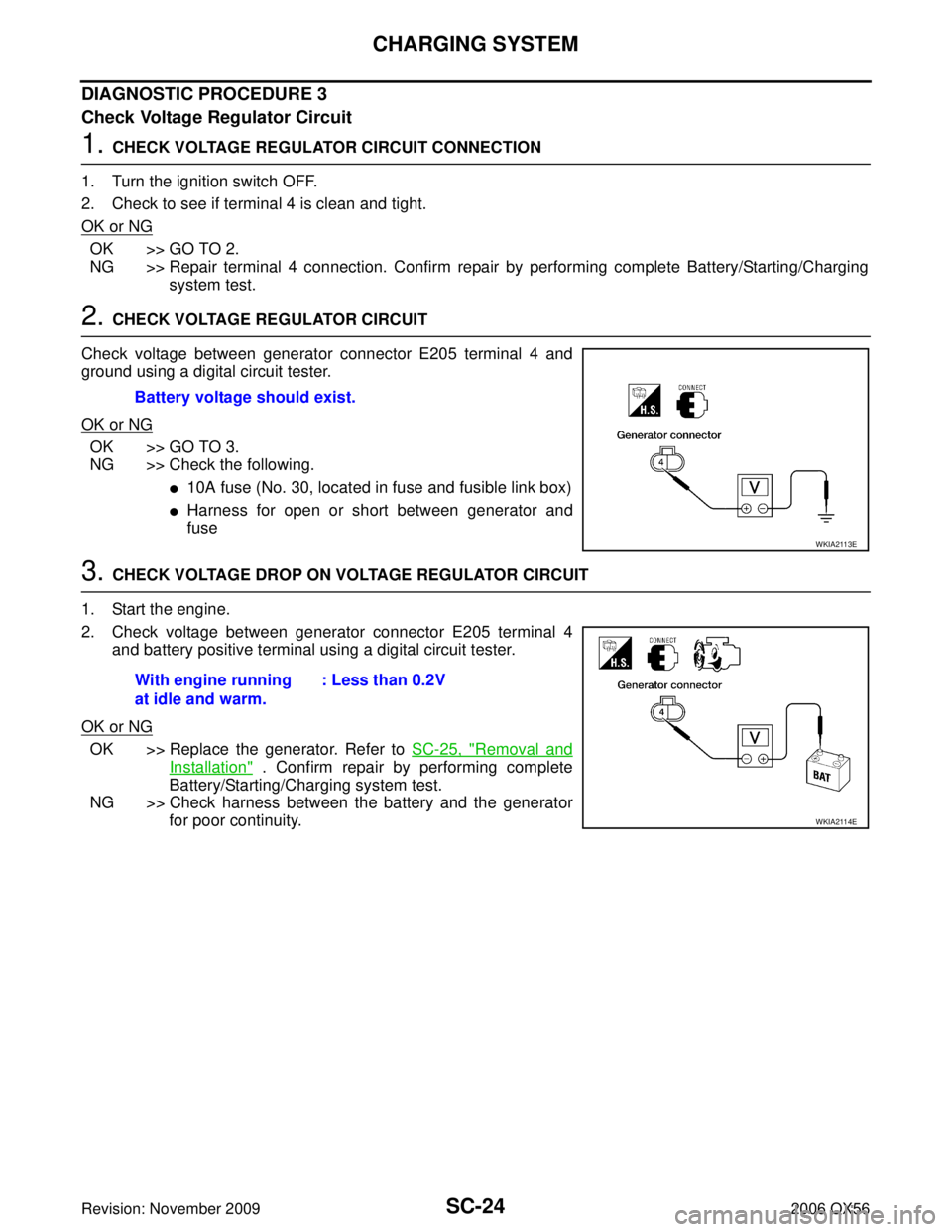
SC-24
CHARGING SYSTEM
Revision: November 20092006 QX56
DIAGNOSTIC PROCEDURE 3
Check Voltage Regulator Circuit
1. CHECK VOLTAGE REGULATOR CIRCUIT CONNECTION
1. Turn the ignition switch OFF.
2. Check to see if terminal 4 is clean and tight.
OK or NG
OK >> GO TO 2.
NG >> Repair terminal 4 connection. Confirm repair by performing complete Battery/Starting/Charging system test.
2. CHECK VOLTAGE REGULATOR CIRCUIT
Check voltage between generator connector E205 terminal 4 and
ground using a digital circuit tester.
OK or NG
OK >> GO TO 3.
NG >> Check the following.
�10A fuse (No. 30, located in fuse and fusible link box)
�Harness for open or short between generator and
fuse
3. CHECK VOLTAGE DROP ON VOLTAGE REGULATOR CIRCUIT
1. Start the engine.
2. Check voltage between generator connector E205 terminal 4 and battery positive terminal using a digital circuit tester.
OK or NG
OK >> Replace the generator. Refer to SC-25, "Removal and
Installation" . Confirm repair by performing complete
Battery/Starting/Charging system test.
NG >> Check harness between the battery and the generator for poor continuity.
Battery voltage should exist.
WKIA2113E
With engine running
at idle and warm.
: Less than 0.2V
WKIA2114E
Page 2942 of 3383
AUTOMATIC DRIVE POSITIONERSE-11
C
DE
F
G H
J
K L
M A
B
SE
Revision: November 2009 2006 QX56
AUTOMATIC DRIVE POSITIONERPFP:28491
Component Parts And Harness Connector LocationEIS0058U
1. Fuse block (J/B)2. Fuse and relay box3. Fuse and fusible link box
4. A. Automatic drive positioner control unit M33, M34
B. Pedal adjusting motor E109,
E110 5. A. Steering column
B. Key switch and key lock solenoid
M27
C. BCM M18, M19, M20 (View with
instrument panel removed) 6. A. Door mirror remote control switch
D10
B. Seat memory switch D5
LIIA2361E
Page 2962 of 3383
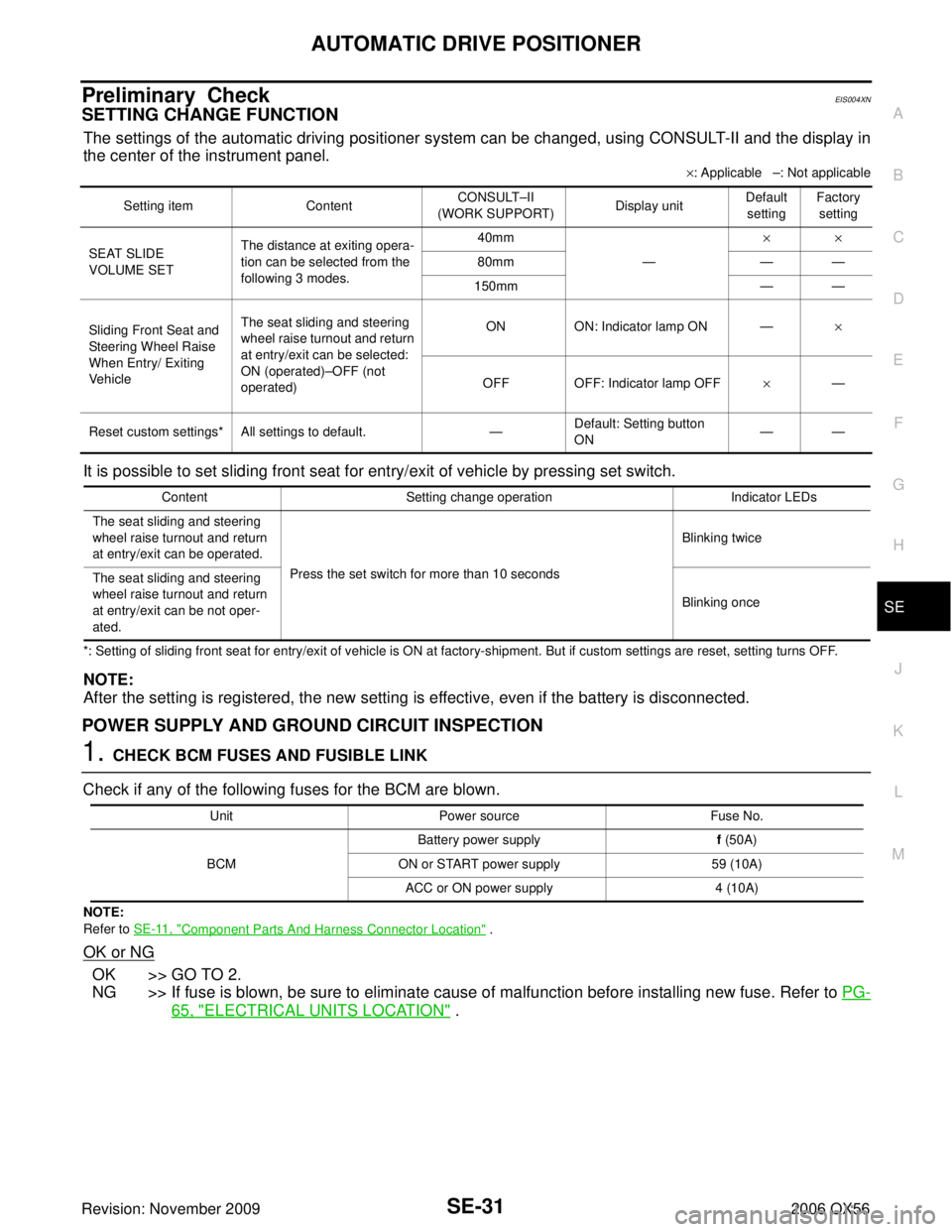
AUTOMATIC DRIVE POSITIONERSE-31
C
DE
F
G H
J
K L
M A
B
SE
Revision: November 2009 2006 QX56
Preliminary CheckEIS004XN
SETTING CHANGE FUNCTION
The settings of the automatic driving positioner system can be changed, using CONSULT-II and the display in
the center of the instrument panel.
×: Applicable –: Not applicable
It is possible to set sliding front seat for entry/exit of vehicle by pressing set switch.
*: Setting of sliding front seat for entry/exit of vehicle is ON at factory-shipment. But if custom settings are reset, setting turns OFF.
NOTE:
After the setting is registered, the new setting is effective, even if the battery is disconnected.
POWER SUPPLY AND GROUND CIRCUIT INSPECTION
1. CHECK BCM FUSES AND FUSIBLE LINK
Check if any of the following fuses for the BCM are blown.
NOTE:
Refer to SE-11, "
Component Parts And Harness Connector Location" .
OK or NG
OK >> GO TO 2.
NG >> If fuse is blown, be sure to eliminate cause of malfunction before installing new fuse. Refer to PG-
65, "ELECTRICAL UNITS LOCATION" .
Setting item ContentCONSULT
–II
(WORK SUPPORT) Display unitDefault
setting Factory
setting
SEAT SLIDE
VOLUME SET The distance at exiting opera-
tion can be selected from the
following 3 modes. 40mm
—××
80mm ——
150mm ——
Sliding Front Seat and
Steering Wheel Raise
When Entry/ Exiting
Vehicle The seat sliding and steering
wheel raise turnout and return
at entry/exit can be selected:
ON (operated)
–OFF (not
operated) ON
ON: Indicator lamp ON —×
OFF OFF: Indicator lamp OFF ×—
Reset custom settings* All settings to default. —Default: Setting button
ON ——
Content
Setting change operation Indicator LEDs
The seat sliding and steering
wheel raise turnout and return
at entry/exit can be operated. Press the set switch for more than 10 seconds Blinking twice
The seat sliding and steering
wheel raise turnout and return
at entry/exit can be not oper-
ated. Blinking once
Unit
Power source Fuse No.
BCM Battery power supply
f (50A)
ON or START power supply 59 (10A)
ACC or ON power supply 4 (10A)
Page 2963 of 3383
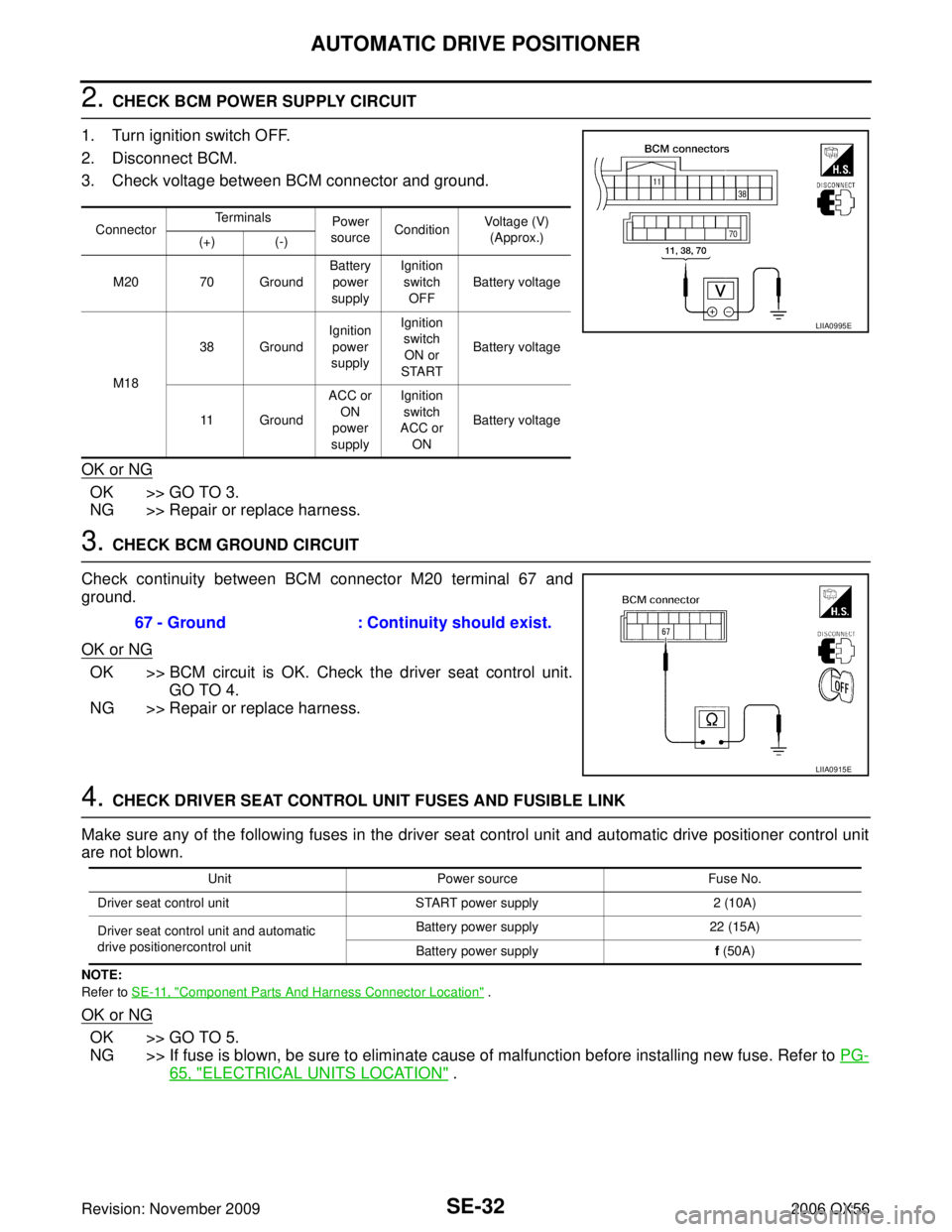
SE-32
AUTOMATIC DRIVE POSITIONER
Revision: November 20092006 QX56
2. CHECK BCM POWER SUPPLY CIRCUIT
1. Turn ignition switch OFF.
2. Disconnect BCM.
3. Check voltage between BCM connector and ground.
OK or NG
OK >> GO TO 3.
NG >> Repair or replace harness.
3. CHECK BCM GROUND CIRCUIT
Check continuity between BCM connector M20 terminal 67 and
ground.
OK or NG
OK >> BCM circuit is OK. Check the driver seat control unit. GO TO 4.
NG >> Repair or replace harness.
4. CHECK DRIVER SEAT CONTROL UNIT FUSES AND FUSIBLE LINK
Make sure any of the following fuses in the driver seat control unit and automatic drive positioner control unit
are not blown.
NOTE:
Refer to SE-11, "
Component Parts And Harness Connector Location" .
OK or NG
OK >> GO TO 5.
NG >> If fuse is blown, be sure to eliminate cause of malfunction before installing new fuse. Refer to PG-
65, "ELECTRICAL UNITS LOCATION" .
Connector Te r m i n a l s
Power
source Condition Voltage (V)
(Approx.)
(+) (-)
M20 70 Ground Battery
power
supply Ignition
switch
OFF Battery voltage
M18 38 Ground
Ignition
power
supply Ignition
switchON or
START Battery voltage
11 Ground ACC or
ON
power
supply Ignition
switch
ACC or
ON Battery voltage
LIIA0995E
67 - Ground
: Continuity should exist.
LIIA0915E
Unit Power source Fuse No.
Driver seat control unit START power supply2 (10A)
Driver seat control unit and automatic
drive positionercontrol unit Battery power supply
22 (15A)
Battery power supply f (50A)